A Theoretical Optimum Tilt Angle Model for Solar Collectors from Keplerian Orbit
Abstract
:1. Introduction
2. Methods
2.1. Coordinate Frames and Orbit Parameters
2.1.1. ECEI Coordinate Frame
2.1.2. ECI Coordinate Frame
2.1.3. ECEF Coordinate Frame
2.1.4. The local Horizontal Coordinate System
- (a)
- rotate angle around Z-axis;
- (b)
- rotate angle (90°−) around Y-axis;
- (c)
- Change X-axis to the opposite direction
2.2. Theoretical Model for Calculating the Sun Position
2.2.1. Kepler Orbit Parameters for Solar in ECEI
2.2.2. Describe the Solar Motion in ECEI
2.2.3. Describe the Solar Motion in ECEF
2.2.4. Description of the Solar Motion in the Local Coordinate System
2.3. Mathematical Solution to Capture Maximum Irradiation
2.3.1. Building a Formula for Maximum Solar Energy Reception under a Mathematical Model
- (1)
- ri under the spherical coordinate system
- (2)
- ri under the Cartesian coordinate system
2.3.2. Solution for This Model
- (1)
- Optimal Azimuth
- (2)
- Optimal Elevation
2.4. Calculation Process
3. Results and Analysis
3.1. Daily Variation of Solar Tilt Angle in Different Months
3.2. Variation of Best Angle with Latitude
3.3. Losses Due to Deviation from the Optimal Angle
4. Conclusions
Author Contributions
Funding
Data Availability Statement
Acknowledgments
Conflicts of Interest
Abbreviations
| ECEI | Earth-centered ecliptic inertial |
| ECI | Earth-centered inertial |
| ECEF | Earth-centered, Earth-fixed |
| CIO | conventional international origin |
| X* | coordinate system |
| R* | rotate matrix |
| obliquity of the ecliptic | |
| N | the prime vertical curvature radius |
| e | the first eccentricity |
| latitude | |
| longitude | |
| h | height above the sea level |
| the semi-major axis of the ellipse | |
| the orbital eccentricity | |
| the orbit inclination | |
| the longitude of ascending node | |
| fs | the true anomaly |
| Perigee angular distance | |
| AU | astronomical unit (149,597,870,691 × 108 km) |
| Ms | the flat anomaly |
| Lsun | solar zodiac longitude |
| D | average angular distance from the Sun to Moon |
| F | |
| Lmoon | average longitude of the Moon |
| the average longitude of the Moon’s ascending node | |
| q | the position and velocity of the Sun |
| GAST | the Earth’s rotation angle from the true vernal equinox to Greenwich Meridian |
| GMST | the mean equinox to Greenwich meridian |
| the nutation in longitude | |
| UT | Universal Time |
| IERS | the International Earth Rotation Service |
| ENU | local east-north-up coordinate frame |
References
- Banerjee, T.; Podjaski, F.; Kröger, J.; Biswal, B.P.; Lotsch, B.V. Polymer photocatalysts for solar-to-chemical energy conversion. Nat. Rev. Mater. 2021, 6, 168–190. [Google Scholar] [CrossRef]
- Yakup, M.A.; Malik, A.Q. Optimum tilt angle and orientation for solar collector in Brunei Darussalam. Renew. Energy 2001, 24, 223–234. [Google Scholar] [CrossRef]
- Shakya, S. Determination of the optimal tilt angle Nepal. Res. J. Phys. Sci. 2019, 7, 8–14. [Google Scholar]
- Abdallah, R.; Juaidi, A.; Abdel-Fattah, S.; Manzano-Agugliaro, F. Estimating the Optimum Tilt Angles for South-Facing Surfaces in Palestine. Energies 2020, 13, 623. [Google Scholar] [CrossRef] [Green Version]
- Zsiborács, H.; Baranyai, N.H.; Vincze, A.; Háber, I.; Weihs, P.; Oswald, S.; Gützer, C.; Pintér, G. Changes of Photovoltaic Performance as a Function of Positioning Relative to the Focus Points of a Concentrator PV Module: Case Study. Appl. Sci. 2019, 9, 3392. [Google Scholar] [CrossRef] [Green Version]
- Racharla, S.; Rajan, K. Solar tracking system—A review. Int. J. Sustain. Eng. 2017, 10, 72–81. [Google Scholar]
- Zhang, J.; Yin, Z.; Jin, P. Error analysis and auto correction of hybrid solar tracking system using photo sensors and orientation algorithm. Energy 2019, 182, 585–593. [Google Scholar] [CrossRef]
- Henriques, D.; Tiba, C. npTrack: A n-Position Single Axis Solar Tracker Model for Optimized Energy Collection. Energies 2021, 14, 925. [Google Scholar]
- Mousazadeh, H.; Keyhani, A.; Javadi, A.; Mobli, H.; Abrinia, K.; Sharifi, A. A review of principle and sun-tracking methods for maximizing solar systems output. Renew. Sustain. Energy Rev. 2009, 13, 1800–1818. [Google Scholar] [CrossRef]
- Breyer, C.; Schmid, J. Global Distribution of optimal Tilt Angles for fixed tilted PV Systems. In Proceedings of the 25th EU PVSEC/ WCPEC-5, Valencia, Spain, 6–10 September 2010. [Google Scholar]
- Adell, A. Determination of the optimum inclination of a flat solar collector in function of latitude and local climatic data. Rev. De Phys. Appliquée 1982, 17, 569–576. [Google Scholar] [CrossRef] [Green Version]
- Kallioğlu, M.A.; Durmuş, A.; Karakaya, H.; Yılmaz, A. Empirical calculation of the optimal tilt angle for solar collectors in northern hemisphere. Energy Sources Part A Recovery Util. Environ. Eff. 2019, 42, 1335–1358. [Google Scholar] [CrossRef]
- Deng, C.; Chen, F. Preliminary investigation on photo-thermal performance of a novel embedded building integrated solar evacuated tube collector with compound parabolic concentrator. Energy 2020, 202, 117706. [Google Scholar] [CrossRef]
- Chinchilla, M.; Santos-Martín, D.; Carpintero-Rentería, M.; Lemon, S. Worldwide annual optimum tilt angle model for solar collectors and photovoltaic systems in the absence of site meteorological data—ScienceDirect. Appl. Energy 2021, 281, 116056. [Google Scholar] [CrossRef]
- Kim, G.Y.; Han, D.S.; Lee, Z. Solar Panel Tilt Angle Optimization Using Machine Learning Model: A Case Study of Daegu City, South Korea. Energies 2020, 13, 529. [Google Scholar] [CrossRef] [Green Version]
- Cheng, H.-Y.; Yu, C.-C.; Hsu, K.-C.; Chan, C.-C.; Tseng, M.-H.; Lin, C.-L. Estimating Solar Irradiance on Tilted Surface with Arbitrary Orientations and Tilt Angles. Energies 2019, 12, 1427. [Google Scholar] [CrossRef] [Green Version]
- Farahmand, M.Z.; Nazari, M.E.; Shamlou, S.; Shafie-khah, M. The Simultaneous Impacts of Seasonal Weather and Solar Conditions on PV Panels Electrical Characteristics. Energies 2021, 14, 845. [Google Scholar] [CrossRef]
- Nfaoui, M.; El-Hami, K. Optimal tilt angle and orientation for solar photovoltaic arrays: Case of Settat city in Morocco. Int. J. Ambient Energy 2020, 41, 214–223. [Google Scholar] [CrossRef]
- Vician, P.; Palacka, M.; Ďurčanský, P.; Jandačka, J. Determination of Optimal Position of Solar Trough Collector. Procedia Eng. 2017, 192, 941–946. [Google Scholar] [CrossRef]
- Gardashov, R.; Eminov, M.; Kara, G.; Kara, E.G.; Mammadov, T.; Huseynova, X. The optimum daily direction of solar panels in the highlands, derived by an analytical method. Renew. Sustain. Energy Rev. 2020, 120, 109668. [Google Scholar] [CrossRef]
- Abood, A.A. A comprehensive solar angles simulation and calculation using matlab. Int. J. Energy Environ. 2015, 6, 367. [Google Scholar]
- Xu, G.; Jia, X. Orbits; Springer: Berlin/Heidelberg, Germany, 2013. [Google Scholar]
- Lu, Y. Positioning, Coordinate System, and Time Standard. In BDS/GPS Dual-Mode Software Receiver: Principles and Implementation Technology; Springer: Singapore, 2021; pp. 1–35. [Google Scholar]
- Xu, G.; Xu, T.; Yeh, T.-K.; Chen, W. Analytical solution of a satellite orbit disturbed by lunar and solar gravitation. Mon. Not. R. Astron. Soc. 2010, 410, 645–653. [Google Scholar] [CrossRef] [Green Version]
- Brouwer, D.; Clemence, G.M. Methods of Celestial Mechanics; Elsevier: New York, NY, USA; London, UK, 2013. [Google Scholar]
- Brumberg, V. Essential Relativistic Celestial Mechanics; CRC Press: Los Angeles, CA, USA, 2017. [Google Scholar]
- Xu, G.; Xu, Y. GPS: Theory, Algorithms and Applications; Springer: Berlin/Heidelberg, Germany, 2016. [Google Scholar]
- Petit, G. Comparision of “Old” and “New” Concepts: Coordinate Times and Time Transformations; Bureau International des Poids et Mesures: Sevres, France, 2002; IERS Technical Note No. 19. [Google Scholar]
- You, R.-J. Transformation of Cartesian to geodetic coordinates without iterations. J. Surv. Eng. 2000, 126, 1–7. [Google Scholar] [CrossRef]
- Xu, G.; Xu, J. On orbital disturbing effects of the solar radiation. Mon. Not. R. Astron. Soc. 2013, 432, 584–588. [Google Scholar] [CrossRef] [Green Version]
- McCarthy, D. International Earth Rotation Service; IERS Conventions: Paris, Italy, 1996. [Google Scholar]
- Chen, W.; Shen, W.; Han, J.; Li, J. Free wobble of the triaxial Earth: Theory and comparisons with International Earth Rotation Service (IERS) data. Surv. Geophys. 2009, 30, 39–49. [Google Scholar] [CrossRef]
- Montenbruck, O.; Armstrong, A.H. Practical Ephemeris Calculations; Springer: Berlin/Heidelberg, Germany, 1989. [Google Scholar]
- Meeus, J. Astronomische Algorithmen; Willmann-Bell, Inc.: Richmond, VA, USA, 1992. [Google Scholar]
- Seago, J.H.; Seidelmann, P.K. Mean Solar Time and Its Connection to Universal Time; Springer International Publishing: Cham, Switzerland, 2017. [Google Scholar]
- Michalsky, J.J. The Astronomical Almanac’s algorithm for approximate solar position (1950–2050). Sol. Energy 1988, 40, 227–235. [Google Scholar] [CrossRef]
- Karafil, A.; Ozbay, H.; Kesler, M.; Parmaksiz, H. Calculation of optimum fixed tilt angle of PV panels depending on solar angles and comparison of the results with experimental study conducted in summer in Bilecik, Turkey. In Proceedings of the International Conference on Electrical & Electronics Engineering, Bursa, Turkey, 26–28 November 2016. [Google Scholar]
- Darhmaoui, H.; Lahjouji, D. Latitude Based Model for Tilt Angle Optimization for Solar Collectors in the Mediterranean Region. Energy Procedia 2013, 42, 426–435. [Google Scholar] [CrossRef] [Green Version]
- China. MoHaU-RDotPsRo. Technical Standard for Solar Water Heating System of Civil Buildings; China Construction Industry Press: Beijing, China, 2018.
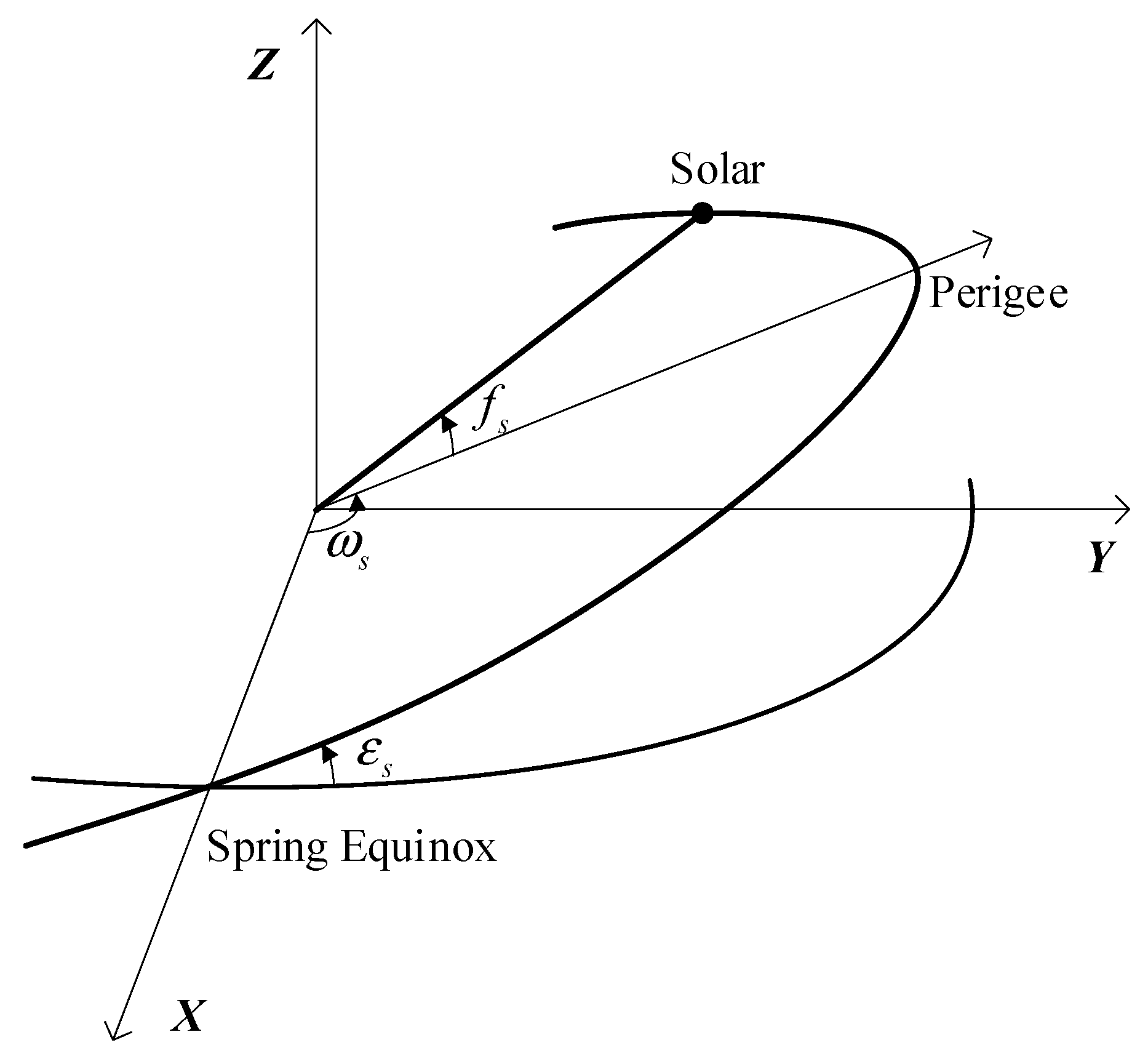
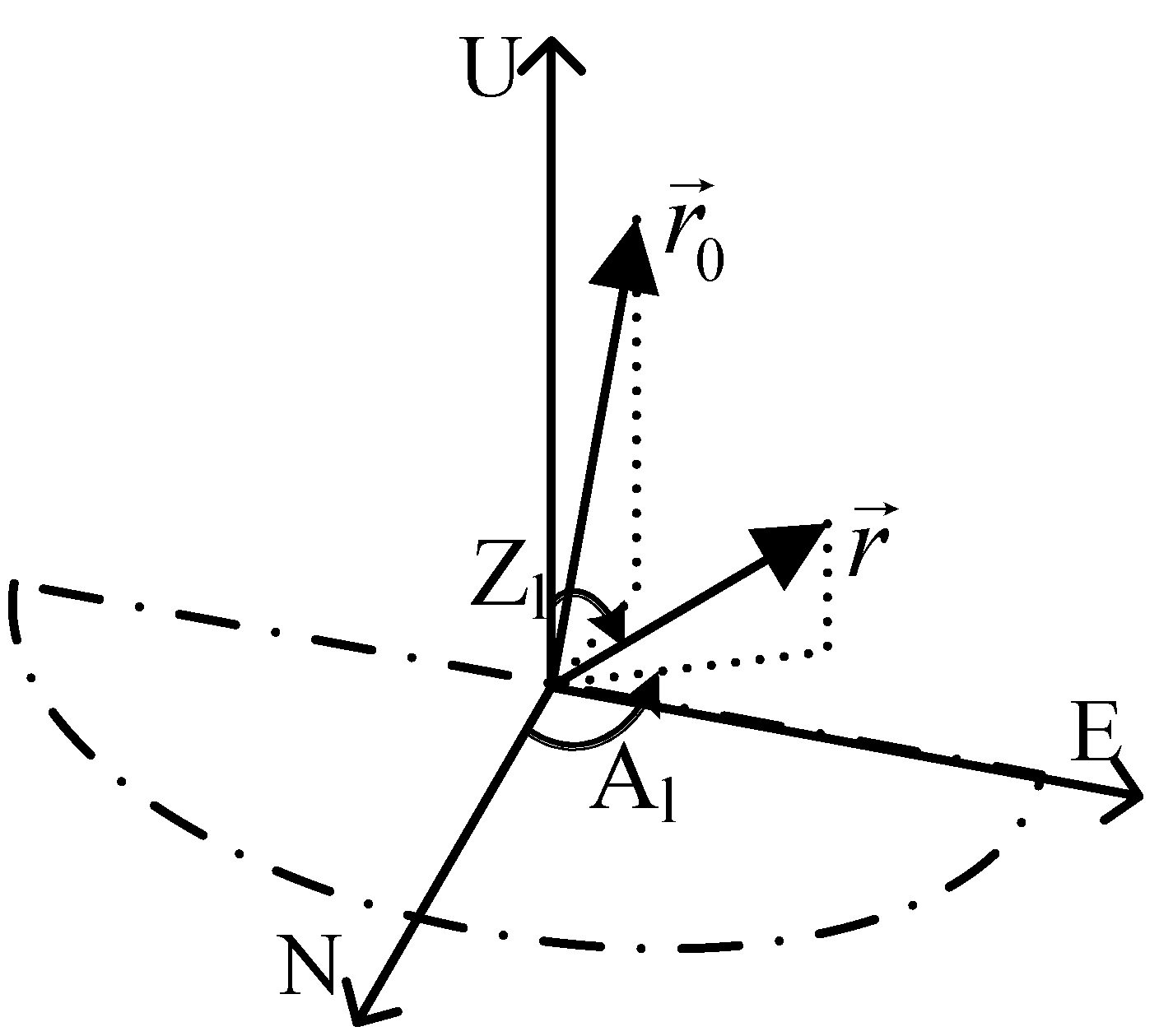
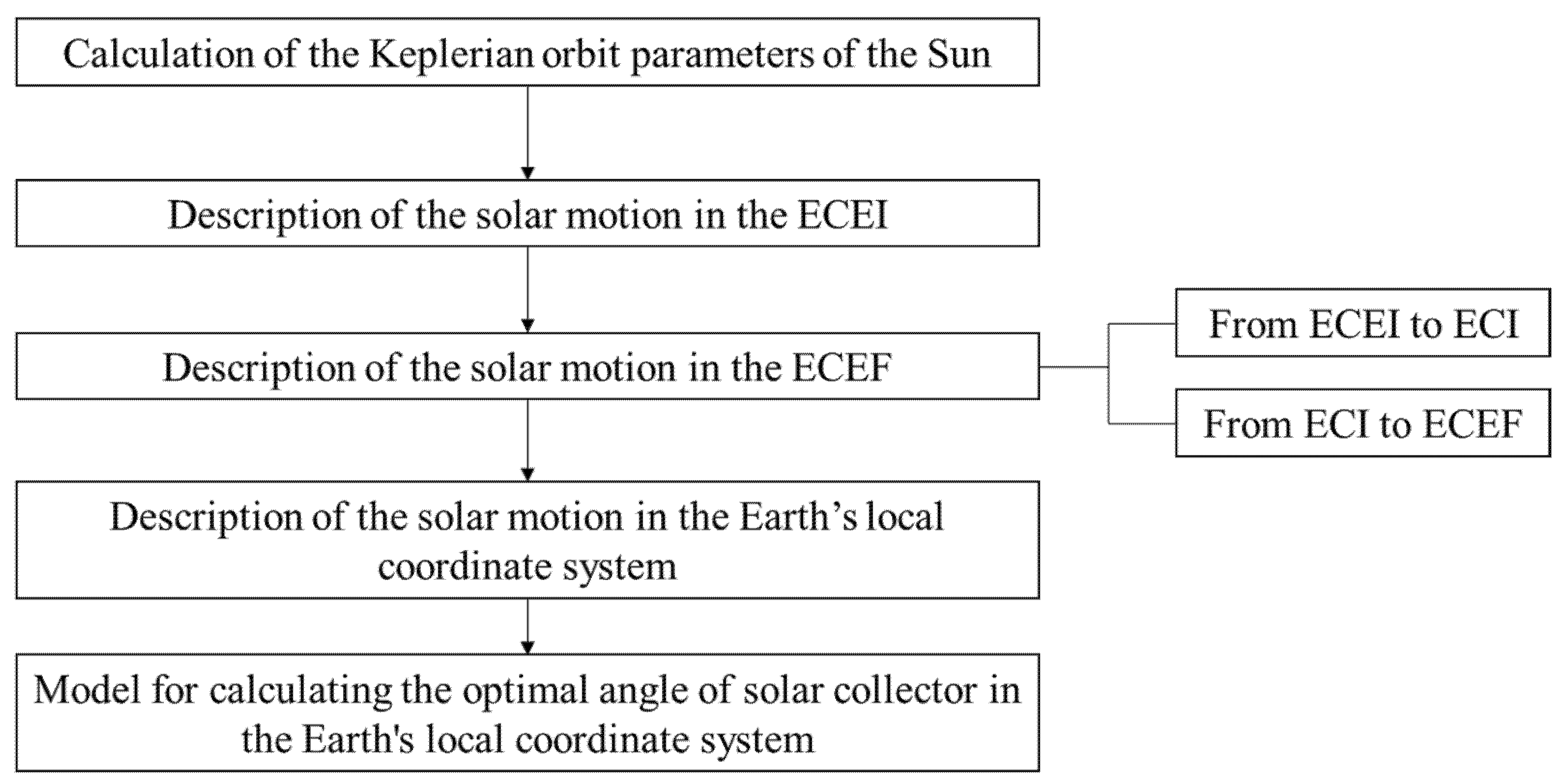
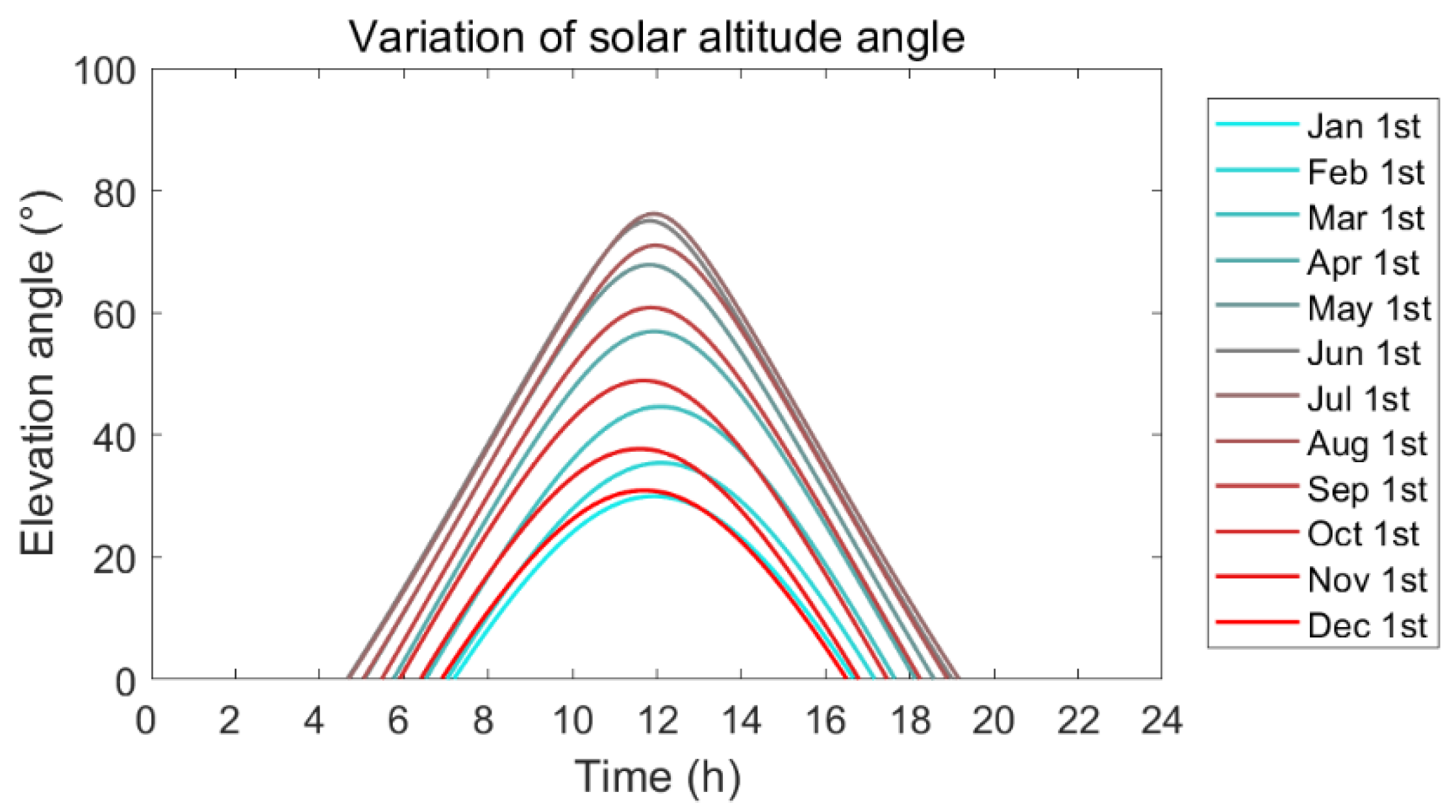
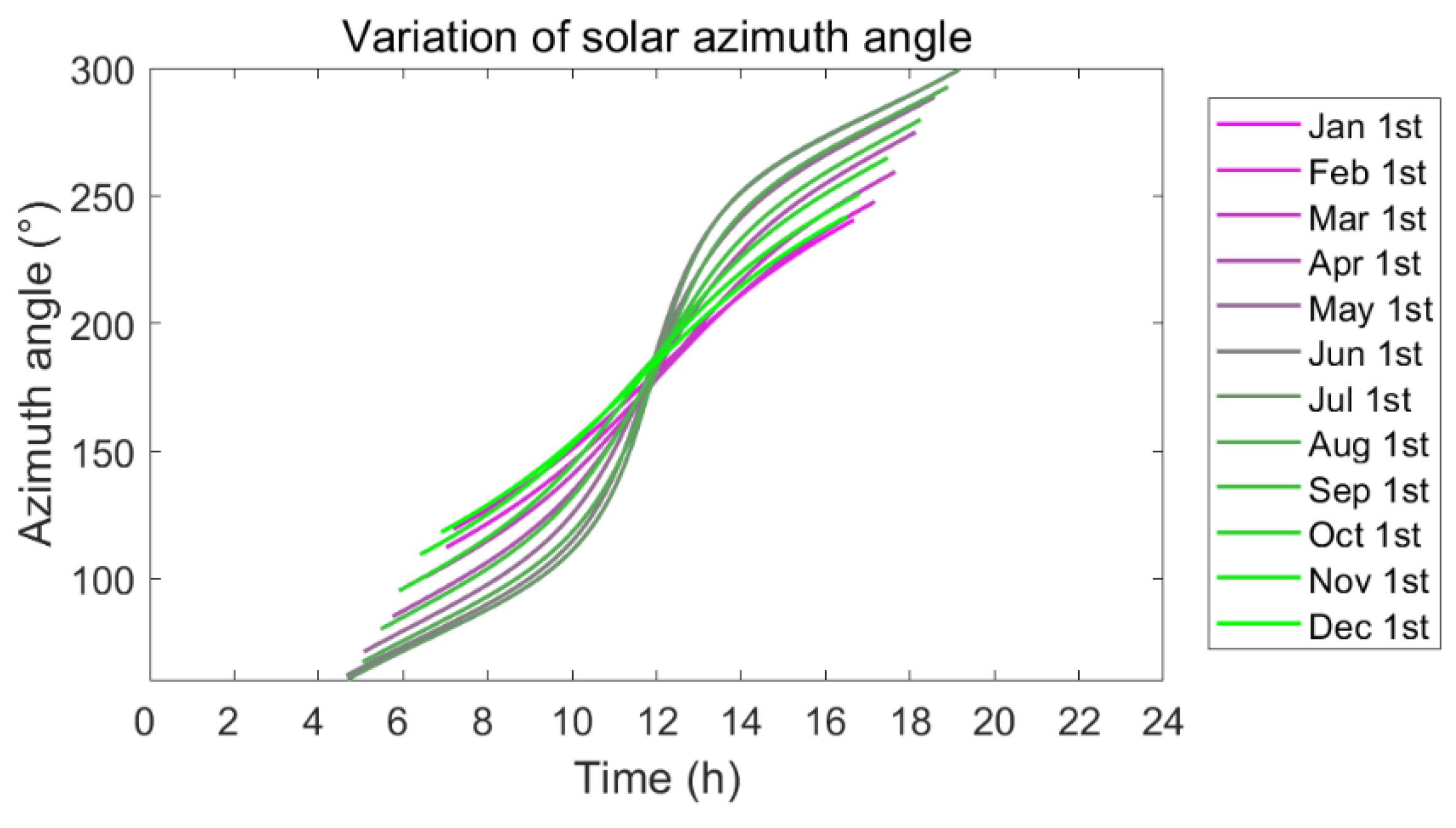
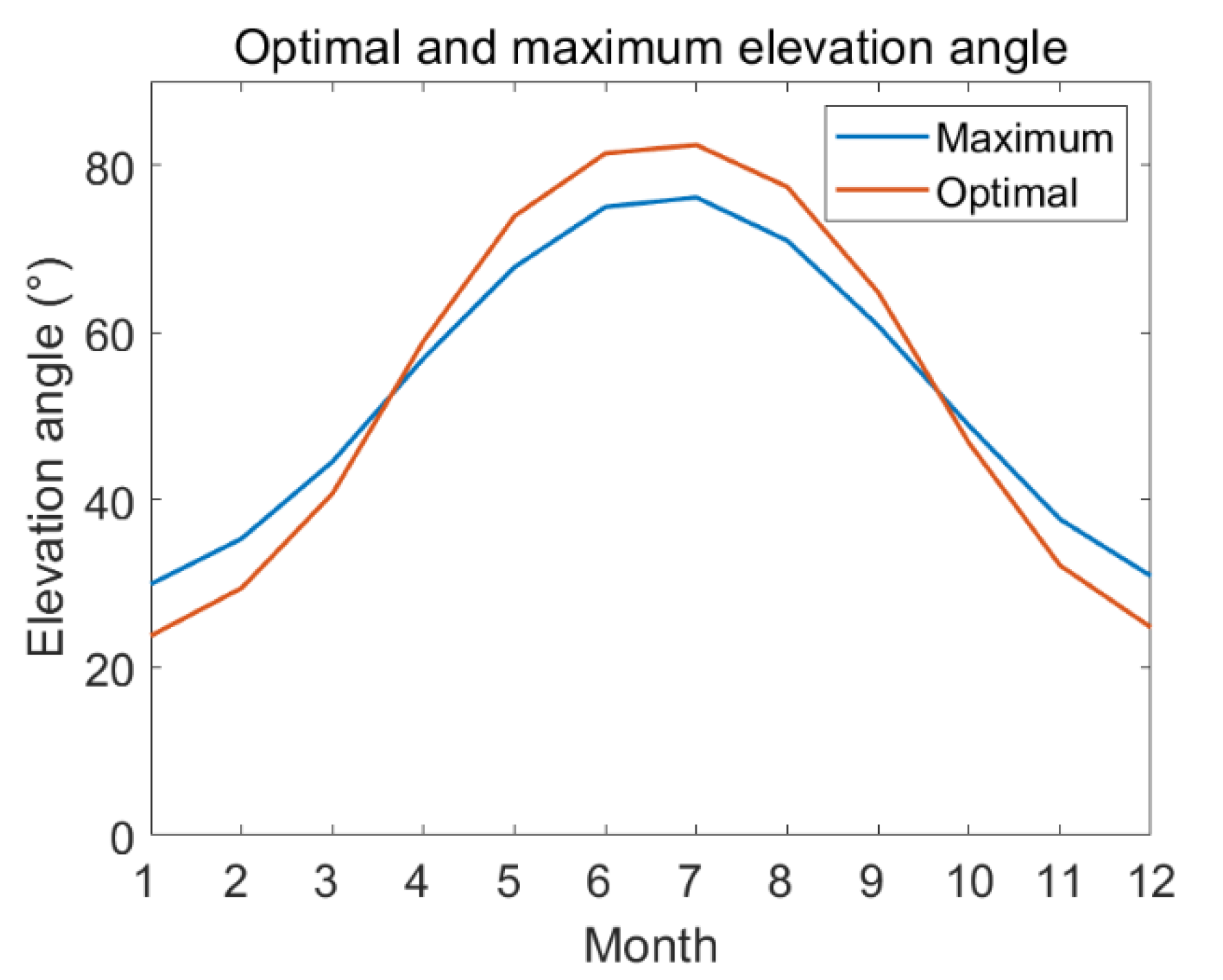
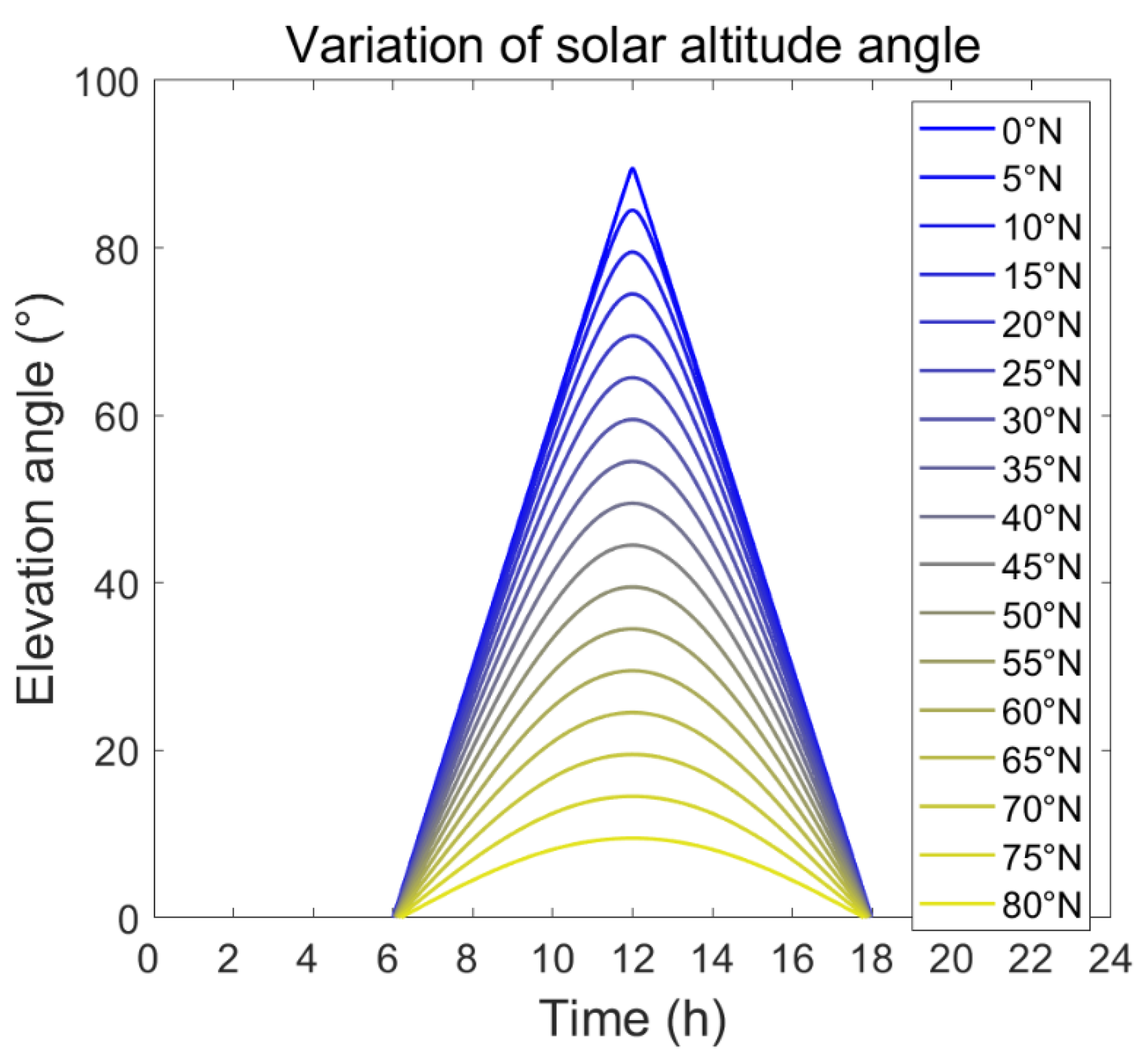
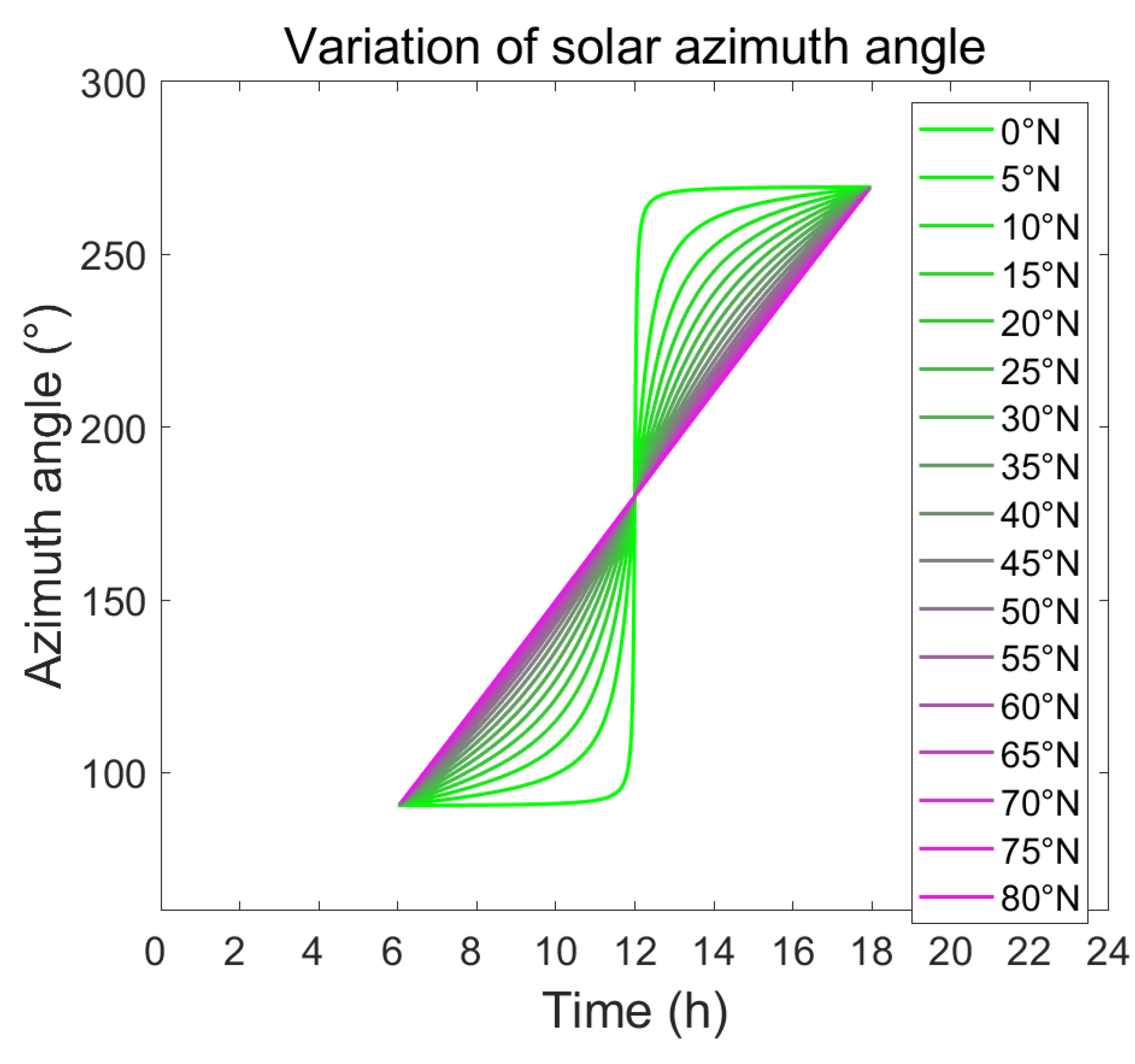
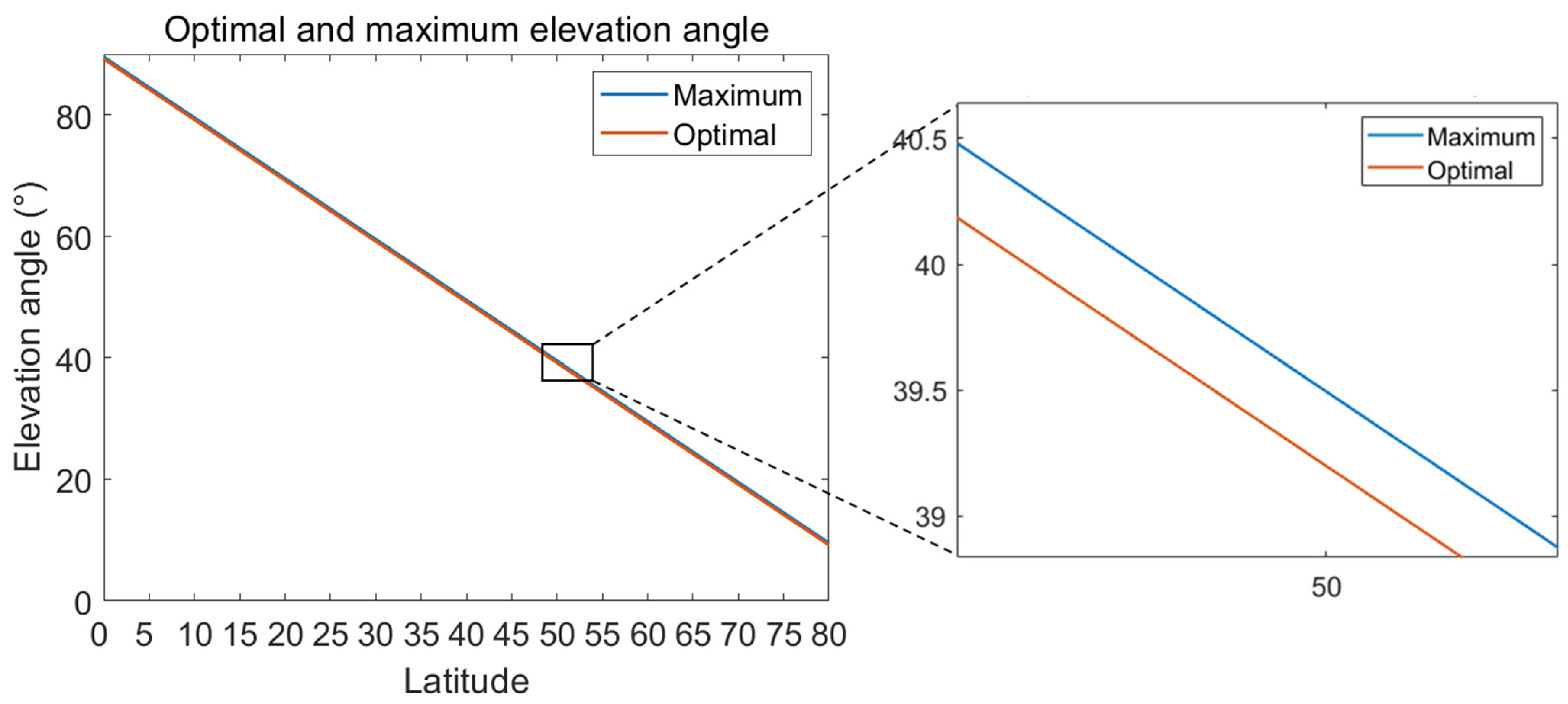
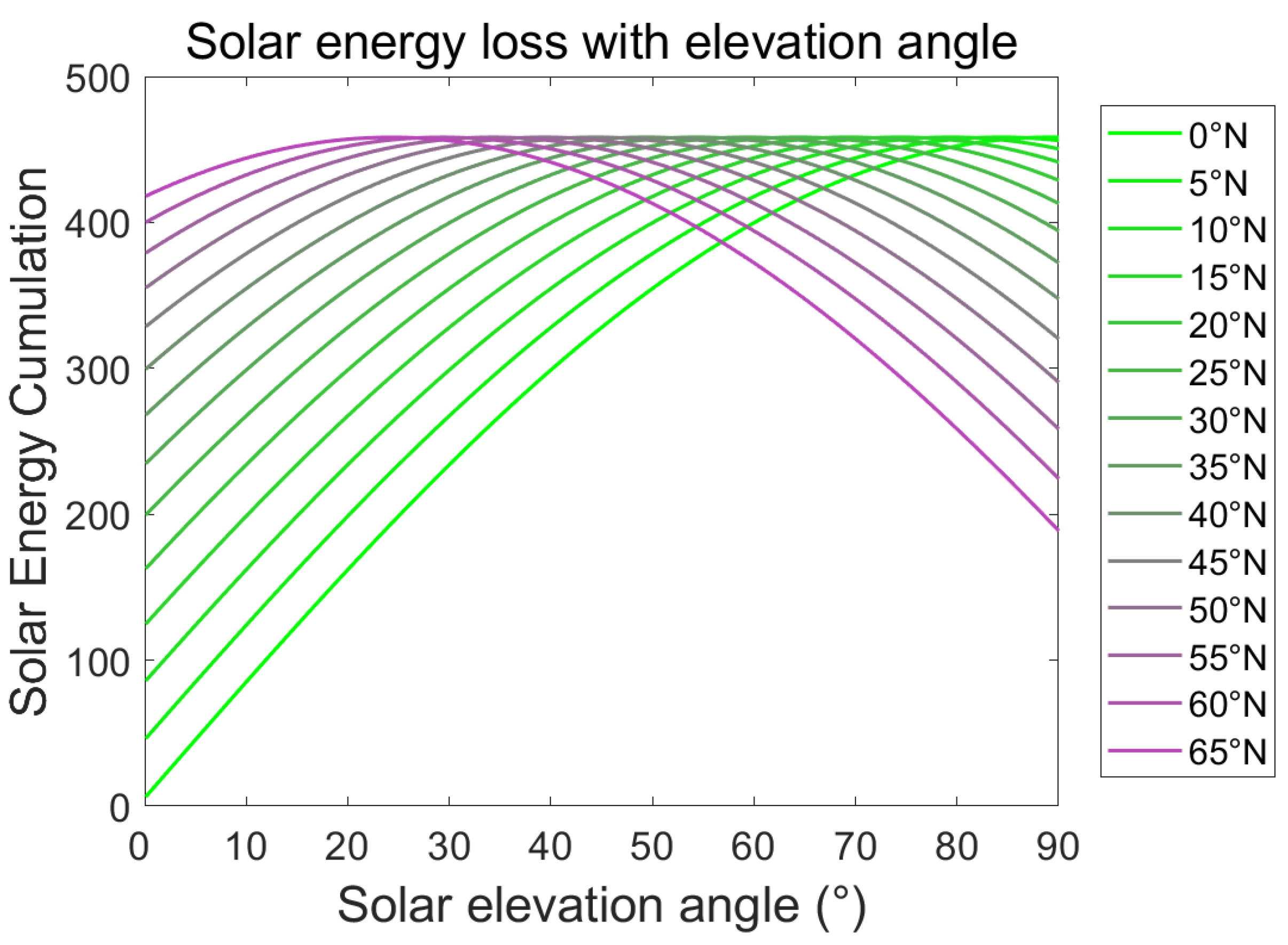
| Month | 1 | 2 | 3 | 4 | 5 | 6 |
| Tilt Angle | 60.03° | 54.58° | 45.39° | 33.08° | 22.18° | 15.00° |
| Month | 7 | 8 | 9 | 10 | 11 | 12 |
| Tilt Angle | 13.86° | 19.02° | 29.18° | 41.12° | 52.29° | 59.07° |
Publisher’s Note: MDPI stays neutral with regard to jurisdictional claims in published maps and institutional affiliations. |
© 2021 by the authors. Licensee MDPI, Basel, Switzerland. This article is an open access article distributed under the terms and conditions of the Creative Commons Attribution (CC BY) license (https://creativecommons.org/licenses/by/4.0/).
Share and Cite
Liu, T.; Liu, L.; He, Y.; Sun, M.; Liu, J.; Xu, G. A Theoretical Optimum Tilt Angle Model for Solar Collectors from Keplerian Orbit. Energies 2021, 14, 4454. https://doi.org/10.3390/en14154454
Liu T, Liu L, He Y, Sun M, Liu J, Xu G. A Theoretical Optimum Tilt Angle Model for Solar Collectors from Keplerian Orbit. Energies. 2021; 14(15):4454. https://doi.org/10.3390/en14154454
Chicago/Turabian StyleLiu, Tong, Li Liu, Yufang He, Mengfei Sun, Jian Liu, and Guochang Xu. 2021. "A Theoretical Optimum Tilt Angle Model for Solar Collectors from Keplerian Orbit" Energies 14, no. 15: 4454. https://doi.org/10.3390/en14154454






